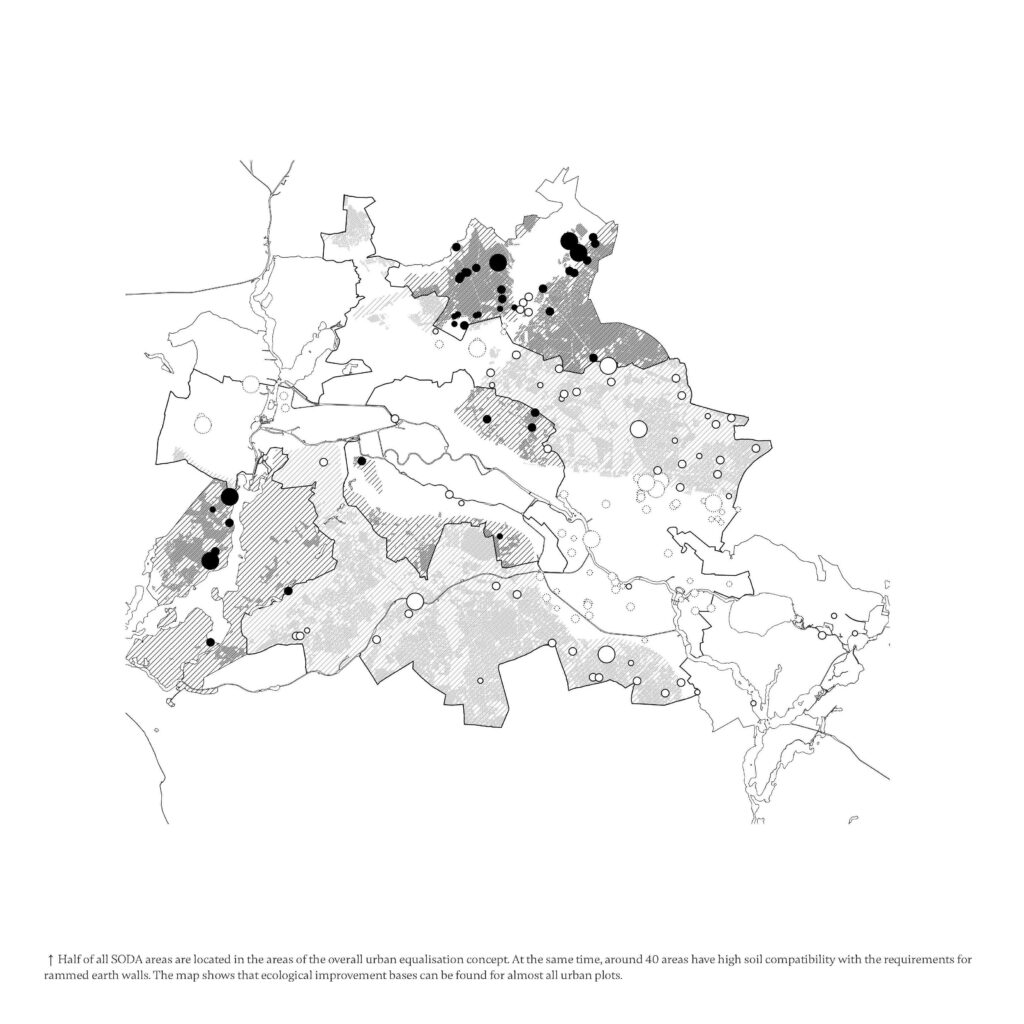Remnants of Speculation addresses the ambivalent relationship of urban ecology and planning economics. Building on one hand on the efforts of city authorities to permanently secure plots of land for future social infrastructures and on the other hand to the development to decouple building measures and their ecological compensation, a different relationship of growth and decay can be outlined. Through in-depth research into all city-owned properties, the project identifies pivotal characteristics in the current economic perspectives on urban nature that takes shape in the form of ecological compensation for the impacts of construction activity.
A starting point of the project is tracing the involvement of the Senate Department of Finance (SenFin) and its administrative spatial power over the 47% of the city’s properties, which the state of Berlin owns. 161 of these so-called SODA (Sondervermögen für Daseinsvorsorge) plots are held for strategic purposes for development of social infrastructure projects within the next 10 years. The fact that this is done at the expense of spatial complexity is touched upon by presenting some of the stories of these properties, which extend the administrative view to the actual physiology of space. Importantly, at the same time, appropriation processes and ecological developments take place on the sites, which are just as important for a city as the projects for which the land is reserved. This ecological development is counterproductive for future projects of social infrastructure. Because it heightens the compensatory measures, the city prevents ecological development at all or acquires compensatory ransom elsewhere – often in so called eco accounts. Besides SODA they are the second essential planning instrument the project researches, because they mediate ecological and economical interrelations.
As the project critically reflects, both planning instruments lose sight of a multitude of relationships by either, in the case of SODA, not conducting a comparison between current necessities and future desires, or, in the case of eco accounts by decoupling ecological connections spatially, temporally, functionally, and responsibility-wise. By engaging in both worlds the project reveals our contradictory view on nature as the relationship defining current building activities and their ecological impact.
Building on the time frames that open up in the analysis of both SODA and eco accounts, the project then proposes to merge them to outline a possibility to reconcile the intensification of ecological connections with the transformative development and construction of properties. It becomes clear that the responsibility of spatial planning is to find ways to couple interventions and compensations in order to resonate with ecological complexity. So what planning arguments can we provide in favour of overcoming the separation of humans (construction activity) and nature (compensation) in order to view them less competitively?
The concept of Ecosoda proposes a link between the two concepts, which does not see the intensification of ecological relationships and construction activity as contradictory, but rather as fundamentally interconnected and interdependent. It proposes to make use of the 10 year span, in which SODA plots lay empty to initiate ecological niches, which can develop in form of an ecological interest. The plots strengthen (either entirely or partially) their ecological value through the maintenance of ecosystems, while planning this very process makes projects of social infrastructure still feasible.
In the context of land speculation this is exemplary test with soil as an ecologically and contextually evident construction material. Scenarios are developed in which rammed earth walls fulfil various functions. From the creation of microclimates, to the temporary use of a greenhouse, to the foundations of a day-care centre, to decay and breeding grounds for sand lizards, for example. The series reflects and embraces the ambivalent, interacting and closely entangled relationship between architecture and urban ecology.
The connection between SODA areas and the eco-account is the argument in favour of the city to develop new building practices that are more strongly measured against integrative ecological building types. After all, a functioning ecosystem is the basis of all Daseinsvorsorge.


















The project Remnants of Speculation is part of the Book Under the Glimmering Surface, together with the projects Contaminated Bodies of Water by Barbara Herschel, Ecologies of Intimacy by Kaspar Jamme and Unruly Ecosystems by Felix Künkel.
Name
Justus Schweer
Year
2023
Type
Master Thesis
